Khas people
| खस/खसिया/पर्वतिया/पहाड़ी | |
|---|---|
| Total population | |
| 210 Million | |
| Regions with significant populations | |
| Languages | |
|
Khas language and regional dialects (e.g; Doteli language) in Nepal Kumaoni and Garhwali in Uttarakhand | |
| Religion | |
|
| |
| Related ethnic groups | |
| Pahari people, Kumaoni people, Garhwali people, Other Indo-Aryan peoples | |
Khas people (Nepali: खस) also called Khas Arya[nb 1] (Nepali: खस आर्य) are an Indo-Aryan[11] ethno-linguistic group native to the Indian subcontinent, what is now present-day Nepal as well as Kumaon, Garhwal and Himachal regions of North India and speak the Khas language (modern Nepali language). They were also known as 'Parbatiyas' and 'Paharis'. The term "Khas" has now become obsolete, as the Khas people have adopted other identities such as Chhetri and Bahun, because of the negative stereotypes associated with the term Khas.[12][13][14]
The hill 'Khas' tribe who are in large part associated with the Gorkhali invaders are addressed with the term Partyā or Parbaté meaning hill-dweller by Newars.[15] The Khas refers to in some contexts not only to the upper-class kshatriya Khas group, i.e. the Bahun and the Chhetri, but in other contexts may also include the low status (generally untouchable) occupational Khas groups such as Kāmi (blacksmiths), Damāi (tailors), Sārki (shoemakers and leather workers).[15]
Origin Theories
They have been connected to the Khasas mentioned in the ancient Hindu literature.[16] Historian Bal Krishna Sharma speculates that the Khas people are of Indo-European origin.[17] Historian Baburam Acharya speculates that Khas are a sub-clan of Aiḍa, an Arya clan originated at Idavritt (modern day Kashmir).[18][nb 2] Khas were living in the Idavaritt in the 3rd millennium B.C.E. and the original meaning of the term Khas was Raja or Kshatriya (Yoddha).[18] He further speculates that Kashmir has been named from its local residents Khas as Khasmirand nepal
History
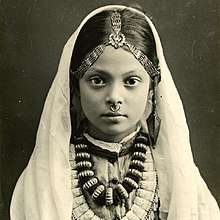
They are believed to have arrived in the western reaches of Nepal at the beginning of first-millennium B.C.[19] or middle of first-millennium A.D.[20] from the north-west. It is likely that they absorbed people from different ethnic groups during this immigration.[21] They have been connected to the medieval Khasa Malla kingdom.[16] In the initial phase, majority of Khas people became Brahmins and others became Kshatriyas.[20]

Until the 19th century, the Gorkhali referred to their country as Khas Desh ("Khas country").[22] As they annexed the various neighbouring countries (such as Newar of the Newar people) to the Gorkha kingdom, the terms such as "Khas" and "Newar" ceased to be used as the names of countries. The 1854 legal code (Muluki Ain), promulgated by the Nepali Prime Minister Jung Bahadur Rana, himself a Khas,[23] no longer referred to "Khas" as a country, rather as a jāt (species or community) within the Gorkha kingdom.[24]
The Shah dynasty of the Gorkha Kingdom, as well as the succeeding Rana dynasty, spoke the Khas language (now called the Nepali language). However, they claimed to be Rajputs of western Indian origin, rather than the native Khas Kshatriyas.[25] Since outside Nepal, the Khas social status was seen as inferior to that of the Rajputs, the rulers started describing themselves as natives of the Hill country, rather than that of the Khas country. Most people, however, considered the terms Khas and Parbatiya (Pahari or Hill people) as synonymous.[22]
The Khas people originally referred to their language as Khas kurā ("Khas speech"), which was also known as Parbatiya ("language of the Hill country"). The Newar people used the term "Gorkhali" as a name for this language, as they identified it with the Gorkhali conquerors. The Gorkhalis themselves started using this term to refer to their language at a later stage.[26] In an attempt to disassociate himself with his Khas past, the Rana monarch Jung Bahadur decreed that the term Gorkhali be used instead of Khas kurā to describe the language. Meanwhile, the British Indian administrators had started using the term "Nepal" (after Newar) to refer to the Gorkha kingdom. In the 1930s, the Gorkha government also adopted this term to describe their country. Subsequently, the Khas language also came to be known as "Nepali language".[27]
Jung Bahadur also re-labeled the Khas jāt as Chhetri in present-day Nepal.[25] Originally, the Brahmin immigrants from the plains considered the Khas as low-caste because of the latter's neglect of high-caste taboos (such as alcohol abstinence).[28] The upper-class Khas people commissioned the Bahun (Brahmin) priests to initiate them into the high-caste Chhetri order and adopted high-caste manners. Other Khas families, which could not afford to (or did not care to) pay the Bahun priests also attempted to assume the Chhetri status but were not recognized as such by others. They are now called Matwali (alcohol-drinking) Chhetris.[14]
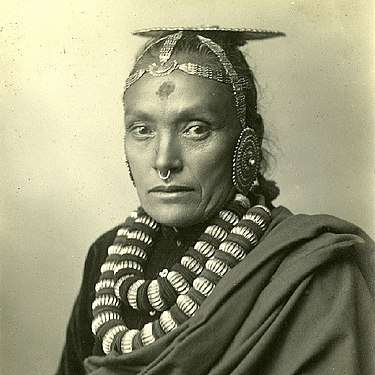 Khas woman (1900s)
Khas woman (1900s)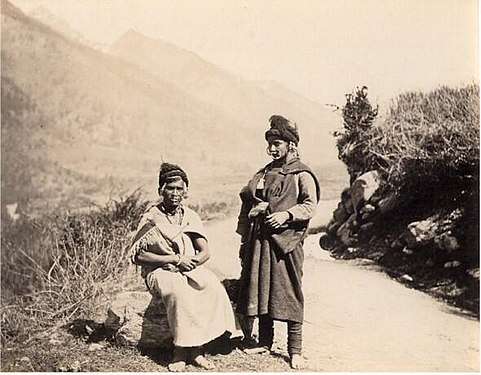 Khas women, photographed in 1880
Khas women, photographed in 1880.jpg) Mukhtiyar Bhimsen Thapa, the widely accepted first Prime Minister of Nepal
Mukhtiyar Bhimsen Thapa, the widely accepted first Prime Minister of Nepal Khas language, Belongs to the north Indo-Aryan Hill group as shown as "Nepali", in purple
Khas language, Belongs to the north Indo-Aryan Hill group as shown as "Nepali", in purple
Because of the adoption of the "Chhetri" identity, the term Khas is rapidly becoming obsolete.[12] According to Dor Bahadur Bista (1991), "the Khas have vanished from the ethnographic map of Nepal".[14]
Modern
Nepal
Modern day Khas people are referred as Khas Brahmin (commonly called as Khas Bahun) , Khas Rajput (commonly called as Khas Chhetri) and Khas Dalits.[29] Khas people are popularly referred in modern times as Khas Arya. As per the explanation of legal provisions of Constitution of Nepal, Khas Arya comprises Brahmin, Kshetri, Thakur and Sanyasi (Dashnami) community.[30] This legal provision excludes Khas Dalits.They are denied quota and reservations in civil services and other sectors due to their history of socio-political dominance in Nepal.[1][2] But they are allowed reservation in federal parliament and provincial legislature.[31] The European Union has been accused of direct interference, creating ethnic strife and negative discrimination towards Khas Arya due to their recommendation to remove the reservation for Khas Aryas.[32][31]
| Khas group | Caste or surname |
|---|---|
| Chhetri[33] | Chhetri (Kshatriya), K.C., Karki, khulal, Bhandari, Khadka, Bisht, Bohora, Chauhan, Thapa, Khatri, Kunwar, Basnet / Basnyat, Gharti-Chhetri (G.C.), Khatri-Chhetri (K.C.), Silwal, Punwar/Panwar, Rawat/Raut, Rana, Ranabhat/Ranavat, Bogati, Budhathoki(B.c), Jamwal, Baruwal, Katwal, Rawal, Rayamajhi, Pandey, Dangi (DC), Dahal, buda |
| Purniya Bahun | Acharya, Adhikari, Bajgain, Baral, Banskota, Banstola, Bhandari, Bhattarai, Chaulagai, Chapagain, Dahal (Rupakheti), Devkota, Dhungel, Ghimire, Guragain, Humagain, Khanal, Koirala, Lamsal/Lamshal, Nepal, Pokharel, Poudel, Rijal, Sigdel, Sanjel, Subedi |
| Kumai Bahun | Awasthi, Bhatta, Bhetwal, Chiluwal, Gyawali, Joshi, Kadel/Kandel, Kharel, Lohani, Mainali, Oli, Pandey, Paneru, Panta, Pathak, Prasai, Regmi, Sangraula, Sedhai, Shiwakoti/Siwakoti, Simkhada, Sitaula, Thapaliya, Upreti |
| Bishwokarma | Bika, Kami, Lohar, Sunar, Od, Chunanra, Parki, Tamata |
| Dalit | Pariyar (Damai, Darjee, Suchikar, Nagarchee, Dholee, Hudke), Mijar (Sarki, Charmakar, Bhool), Gaine, Baadi |
| Thakuri | Thakuri, Bam, Banshi, Barma, Chand , Dev, Hamal, Khand, Malla, Paal, Rathore, Raya, Samal, Sen, Shah, Shahi, Singh, Deuba. |
| Dashnami Sanyasi | Giri, Puri, Bharathi, Ban, Tirtha, Parvat, Sagar, Saraswati, Aashram, Aranya |
- Nepali Khas Parbatiya peoples at a wedding in Narayangarh, Chitwan
.jpg) Procession of Nepali Hindu Wedding; groom wears Dhaka dress used only by Khas Parbattia community
Procession of Nepali Hindu Wedding; groom wears Dhaka dress used only by Khas Parbattia community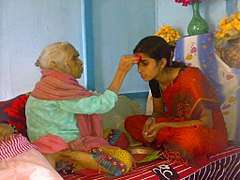 Senior offering Dashain Tika; a feature of Khas Parbattia community
Senior offering Dashain Tika; a feature of Khas Parbattia community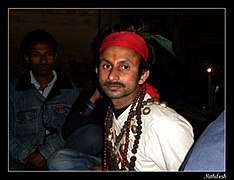 Jhakri, a shamanistic practice evident in modern Khas people in Darjeeling, India
Jhakri, a shamanistic practice evident in modern Khas people in Darjeeling, India
India
In Kumaon and Garhwal regions of Uttarakhand in India, too, the term Khas has become obsolete. The Khas (or Khasia) people of Kumaon adopted the self-designation Kumaoni Jiagahari Rajput, after being elevated to the Rajput status by the Chand kings. The term Khas is almost obsolete, and people resent being addressed as Khas because of the negative stereotypes associated with this tittle. In Jaunsar-Bawar region of Garhwal division majority of people are still recognized by their Khasa (Brahman and Thakurs) identity.
In Himachal Pradesh khasas are found in majority in the region between Sutlej and Yamuna River which includes districts like Shimla, Sirmaur, Solan and Kullu.
Notable people
Notes
- ↑ See[1][2][3][4][5][6][7][8][9][10]
- ↑ Historian Baburam Acharya speculates that in the 3rd millennium B.C.E., there were two clans of Arya in the northern Indian subcontinent; Aiḍa and Mānava. Aiḍa who were named after their homeland Iḍavritt (modern day Kashmir), settled over Panjab and Ganga-Jamuna plain while Mānava settled over Awadh region. Chandravanshi kings like Bharata and Yudhisthir belonged to Aiḍa while Suryavanshi kings like Ramachandra belonged to Mānava. Later, Aiḍa built dominion over Magadh while Mānava had dominion over Videha.[18]
References
- 1 2 Khadka, Suman (25 Feb 2015). "Drawing caste lines". The Kathmandu Post. Retrieved 25 January 2018.
- 1 2 "Khas Arya quota provision in civil services opposed". thehimalayantimes.com. 10 November 2017. Retrieved 1 May 2018.
- ↑ "Nepal's election may at last bring stability". The Economist. Retrieved 1 May 2018.
- ↑ "The Kathmandu Post -PM briefs international community". kathmandupost.ekantipur.com. Retrieved 6 April 2018.
- ↑ Times, Nepali. "Quotable quota". www.nepalitimes.com. Retrieved 1 May 2018.
- ↑ "Next Door Nepal: Another chink in the wall". indianexpress.com. 2 April 2018. Retrieved 1 May 2018.
- ↑ "Oli in balancing avatar". myrepublica.com. Retrieved 1 May 2018.
- ↑ "Nepal seeks unity from its first local elections in 20 years". Nikkei Asian Review. Retrieved 1 May 2018.
- ↑ "Lessons for India From Nepal's History of Banning Cow Slaughter - The Wire". The Wire. Retrieved 1 May 2018.
- ↑ "What does high caste chauvinism look like?". ekantipur.com. Retrieved 1 May 2018.
- ↑ Hagen & Thapa 1998, p. 114.
- 1 2 William Brook Northey & C. J. Morris 1928, p. 123.
- ↑ K. S. Singh 2005, p. 851.
- 1 2 3 Dor Bahadur Bista 1991, p. 48.
- 1 2 Whelpton 2005, p. 31.
- 1 2 John T Hitchcock 1978, pp. 112-119.
- ↑ Sharma 1999, p. 181.
- 1 2 3 Acharya 1975, p. 199.
- ↑ Dor Bahadur Bista 1991, p. 15.
- 1 2 Sharma 1999, p. 112.
- ↑ John T Hitchcock 1978, p. 113.
- 1 2 Richard Burghart 1984, p. 107.
- 1 2 Dor Bahadur Bista 1991, p. 37.
- ↑ Richard Burghart 1984, p. 117.
- 1 2 Richard Burghart 1984, p. 119.
- ↑ Richard Burghart 1984, p. 118.
- ↑ Richard Burghart 1984, pp. 118-119.
- ↑ Susan Thieme 2006, p. 83.
- ↑ John T Hitchcock 1978, pp. 116-119.
- ↑ "Nepal-India Relations: Need for Urgent Paradigm Shift". Mainstream Weekly. Retrieved 2018-09-24.
- 1 2 "Next Door Nepal: The nationalist's hour". The Indian Express. 2018-03-26. Retrieved 2018-09-24.
- ↑ https://www.nepalitimes.com/here-now/hail-to-the-chiefs/
- ↑ Subba, Tanka Bahadur (1989). Dynamics of a hill society: Nepalis in Darjeeling and Sikkim Himalayas. Mittal Publications. ISBN 9788173041143.
Some of the Chhetri clans are Adhikari, Baniya, Basnet, Bist, Bohra, Bura or Burathoki, Gharti, Karki, Khadka, Dhami, Khatri, Khulal, Mahat, Raut, Rana, Roka, Thapa, etc.
- 1 2 3 Pradhan 2012, p. 22.
Bibliography
- Acharya, Baburam (1975), Bhandari, Devi Prasad, ed., "Itihas Kaalbhanda Pahile" (PDF), Purnima, Kathmandu, 8 (1)
- Dor Bahadur Bista (1991). Fatalism and Development: Nepal's Struggle for Modernization. Orient Blackswan. ISBN 978-81-250-0188-1.
- John T Hitchcock (1978). "An Additional Perspective on the Nepali Caste System". In James F. Fisher. Himalayan Anthropology: The Indo-Tibetan Interface. Walter de Gruyter. ISBN 978-90-279-7700-7.
- Toni Hagen; Deepak Thapa (1998). Toni Hagen's Nepal: The Kingdom in the Himalaya. Himal Books.
- K. S. Singh (2005). People of India: Uttar Pradesh. Anthropological Survey of India. ISBN 978-81-7304-114-3.
- Pradhan, Kumar L. (2012), Thapa Politics in Nepal: With Special Reference to Bhim Sen Thapa, 1806–1839, New Delhi: Concept Publishing Company, p. 278, ISBN 9788180698132
- Richard Burghart (1984). "The Formation of the Concept of Nation-State in Nepal". The Journal of Asian Studies. 44 (1): 101–125. doi:10.2307/2056748. JSTOR 2056748.
- Susan Thieme (2006). Social Networks and Migration: Far West Nepalese Labour Migrants in Delhi. LIT Verlag Münster. ISBN 978-3-8258-9246-3.
- William Brook Northey; C. J. Morris (1928). The Gurkhas: Their Manners, Customs, and Country. Asian Educational Services. ISBN 978-81-206-1577-9.
- Whelpton, John (2005). A History of Nepal. Cambridge University Press. ISBN 978-0521804707.
- Sharma, Bal Krishna (1999). The origin of caste system in Hinduism and its relevance in the present context. Indian Society for Promoting Christian Knowledge and Samdan Publishers. ISBN 9788172144968.